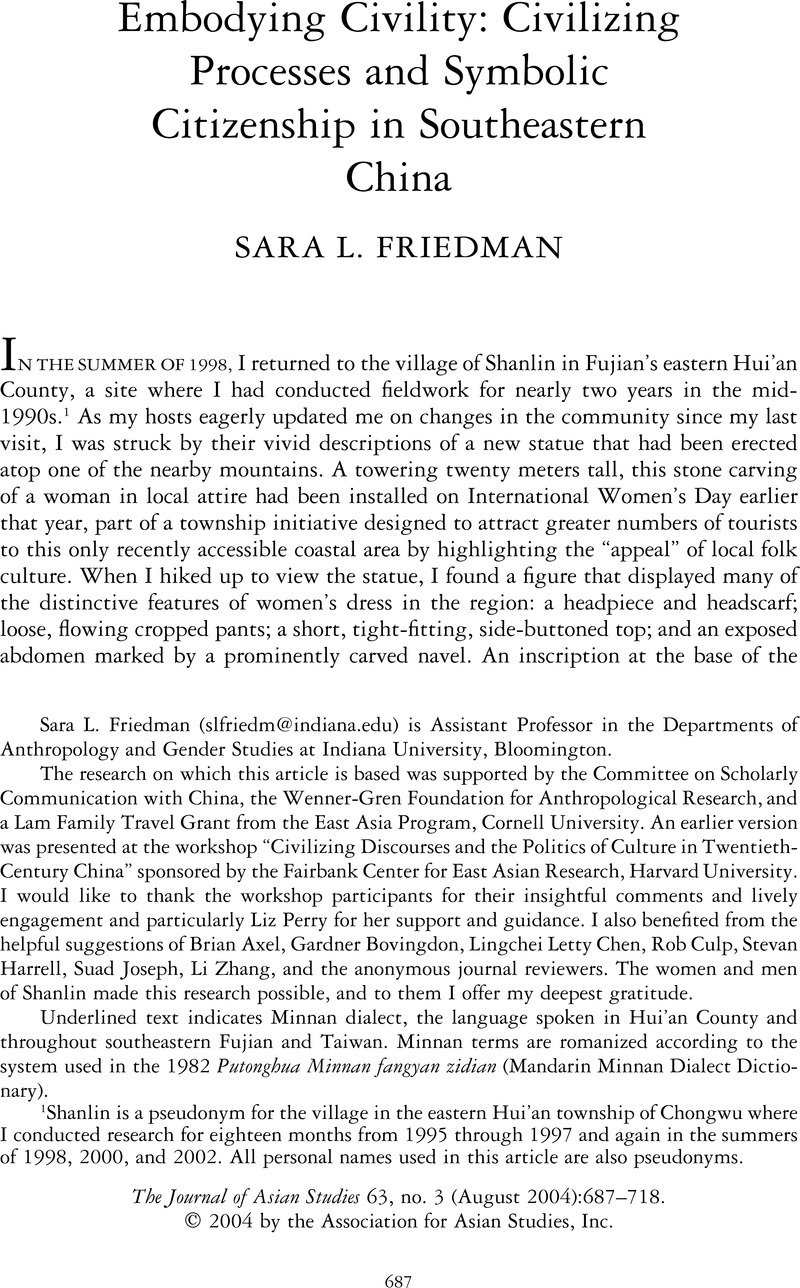Crossref Citations
This article has been cited by the following publications. This list is generated based on data provided by Crossref.
Hershatter, Gail
2004.
State of the Field: Women in China's Long Twentieth Century.
The Journal of Asian Studies,
Vol. 63,
Issue. 4,
p.
991.
Hansen, Karen Tranberg
2004.
The World in Dress: Anthropological Perspectives on Clothing, Fashion, and Culture.
Annual Review of Anthropology,
Vol. 33,
Issue. 1,
p.
369.
Friedman, Sara L.
2005.
The intimacy of state power: Marriage, liberation, and socialist subjects in southeastern China.
American Ethnologist,
Vol. 32,
Issue. 2,
p.
312.
Boswell, Rosabelle
2006.
Say What You Like: Dress, Identity and Heritage in Zanzibar.
International Journal of Heritage Studies,
Vol. 12,
Issue. 5,
p.
440.
Xiaowei, Zang
2006.
Ethnic differences in neighbourly relations in urban China.
Asian Ethnicity,
Vol. 7,
Issue. 2,
p.
195.
SIU, HELEN F.
2007.
Grounding displacement: Uncivil urban spaces in postreform South China.
American Ethnologist,
Vol. 34,
Issue. 2,
p.
329.
Culp, Robert
2007.
Synthesizing Citizenship in Modern China1.
History Compass,
Vol. 5,
Issue. 6,
p.
1833.
HARMS, ERIK
2009.
Vietnam's Civilizing Process and the Retreat from the Street: A Turtle's Eye View From Ho Chi Minh City.
City & Society,
Vol. 21,
Issue. 2,
p.
182.
2009.
Cultural Mobility.
p.
172.
Zang, Xiaowei
2010.
Affirmative Action, Economic Reforms, and Han–Uyghur Variation in Job Attainment in the State Sector in Urumchi.
The China Quarterly,
Vol. 202,
Issue. ,
p.
344.
McDuie-Ra, Duncan
2011.
The dilemmas of pro-development actors: viewing state–ethnic minority relations and intra-ethnic dynamics through contentious development projects.
Asian Ethnicity,
Vol. 12,
Issue. 1,
p.
77.
Shepherd, Robert J.
and
Yu, Larry
2013.
Heritage Management, Tourism, and Governance in China.
Vol. 2,
Issue. ,
p.
33.
Holmes, Ros
2014.
Pillars of Fat: The Corporeal Aesthetics of Civilization (Wenming) in Contemporary Art.
The China Journal,
Vol. 72,
Issue. ,
p.
121.
Nguyen, Minh T.N.
and
Locke, Catherine
2014.
Rural-urban migration in Vietnam and China: gendered householding, production of space and the state.
The Journal of Peasant Studies,
Vol. 41,
Issue. 5,
p.
855.
Sengupta, Mayuri
2015.
Examining State-led Development, Community and the State in Contemporary Tripura (Northeast India).
Forum for Development Studies,
Vol. 42,
Issue. 3,
p.
555.
Suzuki, Michiko
2017.
Reading and Writing Material: Kōda Aya'sKimonoand Its Afterlife.
The Journal of Asian Studies,
Vol. 76,
Issue. 2,
p.
333.
Kimura, Tets
and
Lin, Shih-Ying
2017.
Creation of Contemporary Taiwanese Fashion: A Shift in Tainan City Towards Original Design.
Fashion Practice,
Vol. 9,
Issue. 3,
p.
349.
Hammett, Daniel
and
Jackson, Lucy
2018.
Developing a ‘civil’ society in partial democracies: In/civility and a critical public sphere in Uganda and Singapore.
Political Geography,
Vol. 67,
Issue. ,
p.
145.
Dauncey, Sarah
2020.
Disability in Contemporary China.
Graezer Bideau, Florence
2020.
The Heritage Turn in China.



